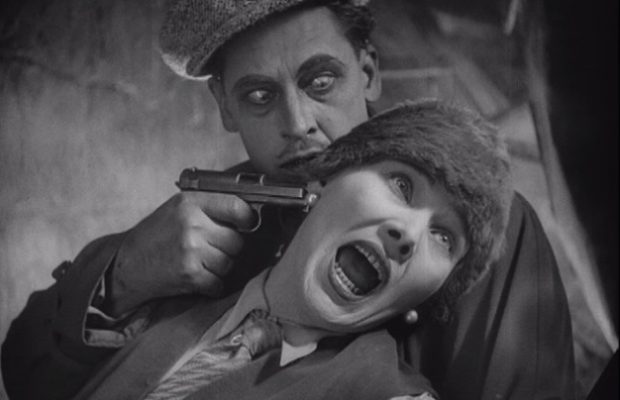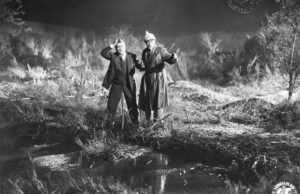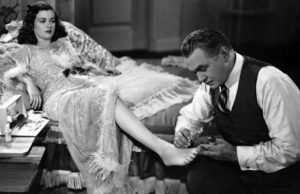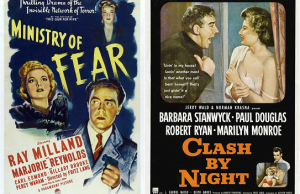Spies (1928)

Toronto Film Society presented Spies (1928) on Monday, October 17, 1960 as part of the Season 13 Monday Evening Silent Film Series, Programme 1.
The German Cinema
Uberfall (Accident) (Germany 1929). Produced, directed and photographed by Erno Metzner. With Heinrich Gotha.
Erno Metzner, who designed the sets for many studio films, later turned to direction himself, but of documentary and realistic, not studio films. After making Free Trip, a propaganda film for the Social Democratic Party, he did this grim account of a “petty bourgeois” encounter with a prostitute, her pimp and a street thug–which uses exactly the same materials as the many German “street” films, but instead of romanticizing them presents the sordid facts in an objective light.
Siegfried Kracauer in From Caligari to Hitler says: “One of the most radical of German films despite its non-political theme–unusual angles, distorting mirrors and other cinematic devices are used in rendering this sordid ‘accident’. The result is a pictorial grotesque tending to color and deform objects and faces. This sabotage of the norm helps to mark Metzner’s film as a protest against deep-rooted conventions. Uberfall is a street film debunking the street films of the stabilized period (e.g. Bruno Rahn’s Tragedy of the Street and Joe May’s Asphalt). Unlike them, it neither glorifies the petty-bourgeois as a rebel nor trnasforms the chaotic street into a haven for genuine love. The prostitute remains a hard-boiled creature to the end. Ruttman’s Berlin, the Symphony of a Great City (which may be shown in the Silent Series next season) also pictures street figures realistically; but while Ruttman retreats into colorless neutrality, Metzner draws radical conclusions from his premises. Uberfall goes beyond Berlin or any other film of the period in that it rebuffs the police, that reassuring symbol of authority on the German screen. It shows chaos without accepting submission to authority as the only way out of it. Authoritarian dispositions are here repudiated emphatically. The truly heretic character of this film is confirmed by the censor’s harsh reaction to it. Even thoug it deals with events far less crude than those of any Pabst film, it was prohibited for its allegedly ‘brutalizing and demoralizing effect’.”
Spies (Germany 1928). Directed by Fritz Lang. Story by Thea von Harbou. Produced by UFA. Camera: Fritz Arno Wagner. Cast: Gerda Maurus, Rudolf Klein-Rogge, Willy Fritsch, Lupu Pick, Fritz Rasp. Released in USA by MGM.
N.Y. Museum of Modern Art Film Notes: “In his earlier Doctor Mabuse, Fritz Lang created a criminal genius whose crimes are committed, not for gain, but for the sake of undermining civilization. In Spies, with Rudolf Klein-Rogge again the master criminal, Lang portrays a machine-age society in which it is almost impossible to tell the evil-doer from the honest citizen. Filled with disguises, trapdoors, sliding panels, and every up-to-date gadget that can be turned to criminal use, it remains a striking example of the crime film.”
Bardeche & Brasillach in History of the Film: “An extremely well-handled detective film which showed Lang to be one of the best craftsmen in the industry”.
Paul Rotha in Celluloid: “A rare instance of a good mystery film handled with intelligence–a skilfully contrived combination of rapid action, complex disguises, plots and counterplots, developed at double speed, with modern settings, efficient camerawork and attractive personalities–an excellent, highly entertaining film realized with a consummate degree of technical accomplishment, but not wholly cinematic in treatment”. (At this time–1931–Rotha felt that Lang did not sufficiently understand the use of editing or cutting to tell a story cinematically.)
Kracauer in From Caligari to Hitler: “The mystery thriller Spies shared two traits with Lang’s Dr. Mabuse. It featured a master spy who, like Mabuse, led several different lives: besides the spy, he was also the president of a bank and a music-hall clown. And exactly like Dr. Mabuse, Spies refrained from conferring moral superiority upon the representatives of the law. Espionage and counterespionage were on the same level–two gangs fighting each other in a chaotic world. Yet there was one important difference: while Mabuse had incarnated the tyrant who takes advantage of the chaos around him, the master spy indulged in the spy business for the sole purpose, it seemed, of spying–a formalized Mabuse devoted to meaningless activities. By emphasizing this figure, the film reflected the neutrality prevalent during that period–a neutrality which also manifested itself in the absence of any distinction between legal and illegal pursuits, and in a prodigal abundance of disguises. No character was what he appeared to be. This constant change of identities was appropriate to denote a state of mind in which the paralysis of the self interfered with any attempt at self-identification. As if to fill the void, Lang piled up sensations which conveyed no meaning. His imaginative virtuosity in shaping them reached its climax with a train wreck in a tunnel. Since it proved impossible to stage the catastrophe in life-size proportions, he gave the impression of it through confused mental images of the persons involved in this shock situation. Spies would have been a true forerunner of the Hitchcock thrillers if Lang had not fashioned it after the pompous manner of Metropolis, so that empty sensations took on the air of substantial revelations. Virtuosity alienated from content posed as art. In accordance with this pretense, UFA issued a volume that was a triumph of bookbinding though it contained nothing but the novel from which the film had been made”.
Of Fritz Lang, Rotha said (in 1931): “From the opening of his film career he consistently associated himself with the flower of technical accomplishment of German studios, and this policy played a large part in his success. He selected the most skilled cameramen, the most creative architects–his scenarios have been adapted from stories by his wife, Thea von Harbou, a well-known writer of sensational thrillers. I have never failed to marvel at Lang’s choice of themes, his flair for things on a big scale, his remarkable fondness for ideas that, on account of their compelling imaginative qualities, are universal in their appeal”. Rotha then speaks of the influence on Lang’s work of the “panorama of new ideas and modern tendencies he feels about him; modern means of transportation, contemporary motifs in architecture, modern painting, cubism, expressionism and surrealism”.
The Silent Film Series has shown three other Lang films: Siegfried, Destiny, Metropolis. Among his other silents: The Woman on the Moon, Kriemhilde’s Revenge, Doctor Mabuse the Gambler. His sound-films include (abroad): “M”, Liliom, The Testament of Doctor Mabuse; and (in the USA): Fury, You Only Live Once, You and Me, Western Union, The Return of Frank James, Men Hunt, Hangmen Also Die, The Woman in the Window, Scarlet Street, The House by the River, Claok and Dagger, The Big Heat, Human Desire, Beyond a REasonable Doubt, While the City Sleeps, Moonfleet, The Secret Beyond the Door.
Lang recently returned to Germany (which he had left after being offered a high post in Nazi films by Goebbels) to make yet a third Mabuse film.
Next Showing: November 28 – Buster Keaton in The General.
Robert Florey’s Life and Death of a Hollywood Extra.















Leave a Reply